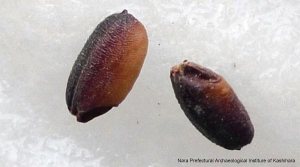Archaeologists discover 2,500-year-old rice – will we ever resurrect it?
Ancient Origins, 26 JANUARY, 2014 by APRIL HOLLOWAY
Archaeologists have uncovered eleven grains of brown rice at a former rice paddy at the Akitsu archaeological site in Goze, Japan. They are believed to date back around 2,500 years. This is not nearly as old as the handful of rice found in Korea Back in 2003 – 15,000-year-old burnt grains which are known to be the oldest known domesticated rice. So why should we be interested in this latest discovery?
Unlike the rice found in Korea, the tiny grains found in Japan, which did not have husks, were incredibly well-preserved because they were sealed in mud with high water content and not exposed to air. According to Professor Tatsuya Inamura, an expert on plant production systems, it is very rare to discover rice this old that has not undergone carbonization. This means that scientists are able to conduct extensive tests on the grains, including DNA analysis, to identify the ancient rice’s variety and gather other information which will help researchers learn about the rice cultivated by ancient people of the period, how rice agriculture started and how it evolved in Japan. Ancient rice is genetically different from the modern food crop, so researchers will be able to trace its evolution.
Rice has been a staple food for many different cultures for thousands of years. In the course of 8,000 years, innovative Asian farmers bred over 10,000 varieties of rice, each suited to different growing conditions and taste. Today, rice is the primary food for over half the world’s population, with more than 700 million tonnes produced each year. Rice is especially important in Asia, where it is responsible for almost a third of all calorific intake. …
– See more at the Ancient Origins website

